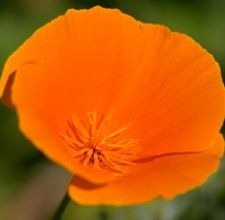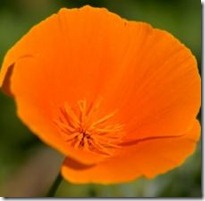California’s state flower, the California poppy (Eschscholzia californica), is native to Northern Mexico and North America’s Pacific Coast. However, this vibrant hardy annual is easily reproduced in both native and non-native environments, and is grown throughout most of the United States, Europe, Asia and Australia.
Reproduction
-
The California poppy reproduces from seeds, and will reach 12 to 18 inches tall with silky, vibrant flowers extending approximately 2 inches across. In the wild, in their native environment, poppies are pollinated by beetles. In other areas, honey bees do this job. After pollination, blooms fall way to seed pods that eventually dry and split open, dropping seeds. Seeds will lay dormant through the winter and then grow the following spring, or they can be collected for later planting. If grown in optimal conditions, poppies will continue to self-sow. Leaving dead poppies in a garden for several weeks will encourage re-seeding.
Planting Poppies
-
 Planting poppies.
Planting poppies.When planting poppies, sow seeds in shallow 1/16 inch well raked soil. Plant poppies in early spring or in the fall. Typically, seeds germinate within three to four weeks, if the ground is warm enough. They grow best in cool temperatures with full sun, and in well-drained sandy soil, although they will grow well in almost any type of soil except clay.
On cloudy days, and during the evening, poppy blooms close, reopening again during sunny daylight hours. They are suitable for xeriscaping, a landscaping method that employs water conservation principles developed for areas susceptible to drought. The California poppy is not a good indoor plant.
Poppy Care
-
 Poppy pod.
Poppy pod.California poppies need minimal care, and disease and insects are not a considerable problem. While ample watering is necessary at the time of planting, once plants are substantial, watering is not needed unless rains are minimal. Snipping dead flowers will encourage re-blooming. Do not over fertilize. They do not grow well in small containers, and if transplanting, it is best to do so when they are young plants, spacing them at least 12 inches apart.
Harvesting Seeds
-
To harvest seeds, wait for the flower blooms to die. Next, cut the seed pods and lay they them out to dry. Once completely dry (they will be brown), remove the seeds from the pod. Seeds can be stored in an envelope in a cool, dry place for later use.
Considerations
-
In native environments, California poppies cooperate with other native species, as native ecosystems are well-ordered environments. Poppies planted in non-native environments can act as non-cooperative weeds, vying competitively for water and nutrients, flowering quickly and producing many seeds to reproduce more than their competitors.


Deprecated: strpos(): Passing null to parameter #1 ($haystack) of type string is deprecated in /home/agriviek8Qv/agriviet.net/public_html/wp-includes/comment-template.php on line 2522